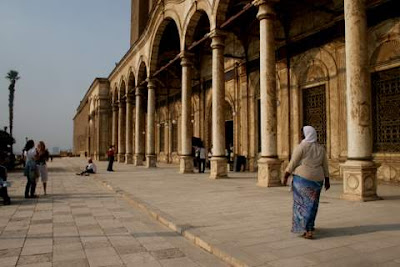"This [Alamein] is not the end, it is not even the beginning of the end. But it is, perhaps, the end of the beginning."
"It may almost be said, 'Before Alamein we never had a victory. After Alamein we never had a defeat.'"
With these two quotes in mind, it is easy to forget the reality - despite the battle being by all accounts a great success and one of the most decisive battles of the Second World War, over 50000 men were killed in total over a period of just two weeks, including around 13,500 from the Commonwealth forces.
The cemetery is located down a slight hill from a road that runs along the coast; after a raucous bus journey the silence is immediate and overwhelming. Markers stretch out in neat little rows perfectly maintained and planted with trees and shrubs, looking out to sea, with a cool breeze swirling the dust underfoot and tugging at the clothes of those in attendance as they wander up and down, scrabbling desperately for something to say but for the most part finding nothing. As the Reverend Mike Parker from Cairo is later to point out, it is an awesome place, in the truest sense of the word; larger by far than an ordinary graveyard, but unlike many sites across Europe, just enough that a single human can begin to comprehend the tragedy.
In an attempt to explain the sensation I remember one of the many drawn-out, contemplative speeches from The History Boys in which Hector comments darkly that on modern-day tours of Auschwitz, 'nothing is apropriate'. Banal chatter fades away here, all self-regarding thoughts forgotten. Even writing about it now feels a little hollow. There are no words to express the profound smallness, nor the solemnity, nor the sorrow visitors cannot help but feel; though it hardly seems to matter, as it is not a day meant for us.
For a militant atheist whose family members as far as I know have not died in war for many generations, I am shocked by the discovery that just one message inscribed on one marker from family or friends, one message of love or religion (or both intertwined), can reduce me to tears and I concentrate instead on not walking over the ground beneath which men are buried, and helping someone look for an MI6 grave I am fairly sure does not exist. A small gathering of people across all nationalities, many of which have served in armies themselves and many more who it later becomes clear have relatives buried here, mills about until their shadows begin to lengthen in the early afternoon, and then the ceremony begins.
It is a beautiful memorial service from start to finish - the British ambassador, James Watt, opens the ceremony and is clearly as moved as anyone else by the surroundings. Wreaths are laid, first by officials from the Commonwealth and Allies and then by private mourners. A section from St. John's Gospel is read, as well as the obligatory but all-encompassing Ode of Remembrance, prayers led and a two-minute silence in this most silent of places dutifully observed. A very young choir from the British School in Alexandria sings two hymns that tug at the heart while soldiers stand around the memorial, eyes down, silhouetted against the darkening sky. No-one is left untouched but, as the ceremony draws to a close and people rise from their seats, chatting, shaking hands, taking last-minute snaps of the final resting place of well over 7000 men, 800 of which will never be identified, everyone is left essentially unchanged - perhaps as they would have wanted.
In full knowledge of my own inadequacy I hand the ending of this post to the esteemed poet John Jarmain, who served in and survived the North African campaign but was later killed in Normandy.
John Jarmain - El Alamein
There are flowers now, they say, at El Alamein;
Yes, flowers in the minefields now.
So those that come to view that vacant scene,
Where death remains and agony has been
Will find the lilies grow ---
Flowers, and nothing that we know.
So they rang the bells for us and Alamein,
Bells which we could not hear.
And to those that heard the bells what could it mean,
The name of loss and pride, El Alamein?
--- Not the murk and harm of war,
But their hope, their own warm prayer.
It will become a staid historic name,
That crazy sea of sand!
Like Troy or Agincourt its single fame
Will be the garland for our brow, our claim,
On us a fleck of glory to the end;
And there our dead will keep their holy ground.
But this is not the place that we recall,
The crowded desert crossed with foaming tracks,
The one blotched building, lacking half a wall,
The grey-faced men, sand-powdered over all;
The tanks, the guns, the trucks,
The black, dark-smoking wrecks.
So be it; none but us has known that land;
El Alamein will still be only ours
And those ten days of chaos in the sand.
Others will come who cannot understand,
Will halt beside the rusty minefield wires
And find there, flowers.























































